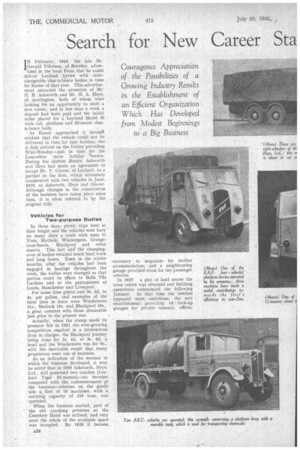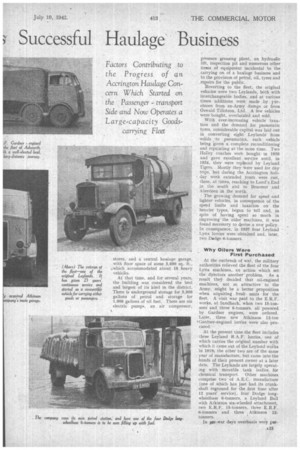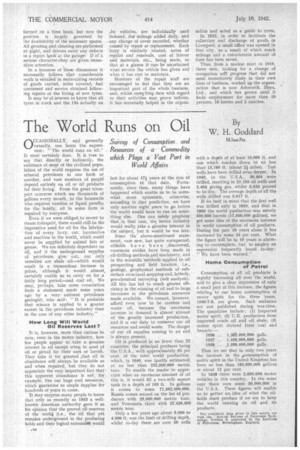Search for New Career Sta ; Successful Haulage Business
Page 26

Page 27

Page 28

If you've noticed an error in this article please click here to report it so we can fix it.
Courageous Appreciation of the Possibilities of a Growing Industry Results in the Establishment of an Efficient Organizationi Which Has Developed from Modest Beginnings to a Big Business Factors Contributing to the Progress of an Accrington Haulage Concern Which Started on the Passenger transport Side and Now Operates a Large-capacity. Goods
carrying Fleet
IN February, 1919, the late •Mr. Oswald Tillotson, of ,Burnley, advertised in the local Press that he could deliver Leyland lorries with interchangeable char-a-bancs bodies in time for Easter of that year. This advertisement attracted the attention of Mr. H. B. Ashworth and Mr. H. A. Heys, of Accrington, both of whom were looking for an opportunity to start a new career, and in less than -a week a deposit had been paid and the initial order placed for a Leyland Model Mwith cab, platform and 32-seater chara.-bancs body. As Easter approached it becamt evident that the vehicle could not be delivered in time for that holiday, but it duly arrived on the Friday preceding Whit-Monday—just in time for the Lancashire main holiday °season. During the interim Messrs. Ashworth and Heys had made an agreement to accept Mr. T. Glover, of Leyland, as a partner in the firm, which ultimately commenced with two vehicles in June, 1919, as Ashworth. Heys and Glover. Although changes in the constitution of the business have taken place since then, it is often referred to by the original titl.e.
Vehicles for Two-purpose Duties In those days, picnic trips were at their height and the vehicles were busy ' on many days a week with runs to York, Matlock, Windermere, Grangeover-Sands, Blackpool and other resorts. This fact and the changingover of bodies entailed much hard work and long 'hours. .Even in the winter months, after the vehicles had been engaged in haulage throughout the week, the bodies were changed so that parties could be talen to Belle Viie Gardens and to the pantomimes at Leeds, Manchester and Liverpool.
For some time petrol cost 3s. 6d. to 4s. per gallon, and examples of the • fares then in force were Windermere 21s., Matlock 18s. and Blackpool 105., a great contrast with those obtainable just prior to the present war.
Actually, when the slump made its presence felt in 1921 the. ever-growing competition resulted in a tremendous drop in charges, the Blackpool journey being done for 2s. 6d. or 3s, 6d. a head and the Windermere run for 9s., with the inevitable result that many proprietors went out of busineSs.
As • an indication of the manner in which the business developed, it may be noted that in 1939 Ashworth, Heys, Ltd., still possessed two coaches (Leyland Tiger 32-seaters)—no increase compared with the commencement of the business—whereas on the goods side a, fleet of 18 machines, with a carrying capacity of 150 tons, was operated.
When the busineis started, part of the old coaching premises at the Cemetery Hotel was utilized, and very soon the whole of the available space was occupied. By 1926 it became necessary to negotiate for further accommodation, and a neighbouring garage provided room for the passenger vehicles.
In 1927 a plot of land nearer the town centre was obtained and building operations commenced the following January. At that time the Ventbre appeared most ambitious, the new establishment providing 14 lock-hp garages for private tenancy, offices, stores, and a central haulage garage, with floor space of some 5,600 sq. ft., ,which accommodated about 18 heavy vehicles.
At that time, and for several years, the building was considered the best and largest of its kind in the district. There is underground storage for 5,000 gallons of • petrol and storage for 1,000 gallons of oil fuel. There are six electric pumps, an air compressor, pressure greasing plant, an hydraulic lift, inspection pit and numerous other items of equipment incidental to the carrying on of a haulage business and to the provision of petrol, oil, tyres and repairs for the public.
Reverting to the fleet, the original vehicles were two Leylands, both with interchangeable bodies, and at various times additions were made by purchases from ex-Army dumps or from Oswald Tillotson, Ltd. A few vehicles were bought, overhabled and sold.
With ever-increasing vehicle taxation and the demand for pneumatic tyres, considerable caPital Was laid out in converting eight Leylandg from
• solidsto pneumatics, each vehicle being 'given a complete reconditioning and repainting at thesame time. Two Halley coaches were bought in 1926 and gave excellent service until, in 1934, they were replaced by Leyland Tigers. . Mostly they were used for day trips, but during the Accrington hob.. day week extended tours were run, these, at times, reaching to Land's End in the south and to Braemar and Aberdeen in the north.
\ The growing • demand for speed and lighter vehicles, in consequence of the speed limits and taxation on the heavier types, began to tell and, in spite of having spent so much in improving the older. machines, it was found necessary to devise a new policy. In consequence, in 1937 four Leyland Lynx lorries were obtained and, later, two Dodge 6-thrillers.
Why Oilers Were
First Purchased.
At the outbreak of war, the military authorities relieved the fleet of the four Lynx machines, an action which set the directors anotherproblem. As a result they decided that oil-engined machines, not so attractive to the Army, might be a better proposition when aequiring freshunits for the fleet. A visit was paid to the E.R.F. works, at Sandbach, when two 15-tonners and three 6-tanners, all powered by Gardner engines, were ordered. 'Later, three new Atkinson 12-ton ,Gardner-engined lorries were also procured.
At the present time the fleet includes three Leyland R.A.F. lorries, one of which carries the original number with which it came out of the Leyland works in 1919; the other two are of the same year of manufacture, but came into the hands of their present owner at a later date. The Leylands are largely operating with movable tank bodies, for chemical transport. Other machines comprise two of A.E.C. manufacture (one of which has just had its crankshaft reground for the first time after 12 years' service), four Dodge longwheelbase 6-tonners, a Leyland Bull with Atkinson six-wheeled attachment, two E.R.F. 15-tanners, three E.R.F. 6-tonners and three , Atkinson 12tonners.
In gio-War days overhauls were per
formed on a time basis, but now the position is largely governed by the availability of the necessary spares. All greasing and cleaning are performed at•pight, and drivers enter any defects in a report 'look at the garage: If of 'a serious charactecethey are given.imme diate attention.
In a business of these dimensions it necessarily follows that considerable work is entailed in .maintaining records of goods carried, miles covered, • fuel consumed and service obtained following repairs or the fitting of new tyres.
It may be of interest to know that all tyres in stock and the 134 actually on ,.he vehicles, are individually card indexed, the mileage added daily, and any change of cover recorded, whether caused by repair or replacement. Each lorry is similarly treated, notes of repairs and renewals, cost of labour and materials, etc., being made, so that at a glance it can be ascertained what service the vehicle has given and what it has cost to maintain.
Members of the repair staff are encouraged to feel that they are an important part of the whole business, and, whilst compiling data with regard to their activities may prove tedious, it has materially helped in the organi
zation and acted as a guide to rates.
In 1932, in order to facilitate the collection and discharge of goods in Liverpool, a small office was opened in that city, as a result of which much mileage and a considerable amount of time has been saved.
Thus, from a modest start in 1919, three men, looking for a change of occupation an% progress that did not seem immediately likely in their own lines of business, worked up the organization that is now Ashworth, Heys, Ltd., and which has grown until it finds employment for more than 50 persons, 18 lorries and 2 coaches.




















































